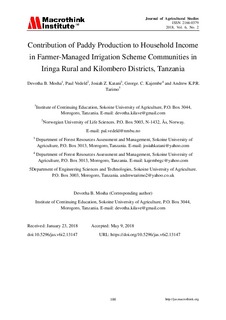| dc.contributor.author | Mosha, Devotha B. | |
| dc.contributor.author | Vedeld, Pål Olav | |
| dc.contributor.author | Katani, Josiah Z. | |
| dc.contributor.author | Kajembe, George C. | |
| dc.contributor.author | Tarimo, Andrew K. | |
| dc.date.accessioned | 2019-02-26T14:19:33Z | |
| dc.date.available | 2019-02-26T14:19:33Z | |
| dc.date.created | 2019-01-14T10:48:57Z | |
| dc.date.issued | 2018 | |
| dc.identifier.citation | Journal of Agricultural Studies. 2018, 6 (2), 100-102. | nb_NO |
| dc.identifier.issn | 2166-0379 | |
| dc.identifier.uri | http://hdl.handle.net/11250/2587591 | |
| dc.description.abstract | Irrigation reduces risks involved in agriculture and enables farming throughout the year. Improved irrigation systems enhance access to irrigation water. However, most smallholder farmers continue to use traditional irrigation schemes as if the difference in water use and crop yields between the two is insignificant. It seems essential to assess the paddy crop yield difference and its contribution to household incomes between traditional and semi-improved Farmer-Managed Irrigation Schemes (FMISs) in Iringa Rural and Kilombero districts in Tanzania. A cross-sectional research design was used in this study involving 48 key informants and 172 randomly selected households. Household survey using a structured questionnaire was the major method for data collection. Data from focus group discussions and key informants supplemented the information collected using household survey. The data were analyzed using Statistical Product and Service Solutions (SPSS). Results indicate that yield of paddy was higher in semi-improved schemes (2.5-3.6 tons/ha) compared to traditional irrigation schemes (2.2-2.9 tons/ha). This was attributed to the presence of improved water intake structures and existence of main canals, which facilitated an improved water supply to the irrigation fields. In spite of the poor and incomplete irrigation infrastructure, the paddy production contributed very significantly (73-80%) to the total annual household income of smallholder irrigators and somewhat more in the improved system than the traditional system. Other income sources are quite marginal in the study areas. The study recommends that the government should invest in irrigation infrastructure development to increase irrigation water use efficiency and increase agricultural values added. | nb_NO |
| dc.language.iso | eng | nb_NO |
| dc.rights | Attribution-NonCommercial-NoDerivatives 4.0 Internasjonal | * |
| dc.rights.uri | http://creativecommons.org/licenses/by-nc-nd/4.0/deed.no | * |
| dc.title | Contribution of Paddy Production to Household Income in Farmer-Managed Irrigation Scheme Communities in Iringa Rural and Kilombero Districts, Tanzania | nb_NO |
| dc.type | Journal article | nb_NO |
| dc.description.version | publishedVersion | nb_NO |
| dc.source.pagenumber | 100-102 | nb_NO |
| dc.source.volume | 6 | nb_NO |
| dc.source.journal | Journal of Agricultural Studies | nb_NO |
| dc.source.issue | 2 | nb_NO |
| dc.identifier.doi | 10.5296/jas.v6i2.13147 | |
| dc.identifier.cristin | 1656004 | |
| dc.relation.project | Utenriksdepartementet: EPINAV | nb_NO |
| cristin.unitcode | 192,13,1,0 | |
| cristin.unitname | Institutt for internasjonale miljø- og utviklingsstudier | |
| cristin.ispublished | true | |
| cristin.fulltext | original | |

